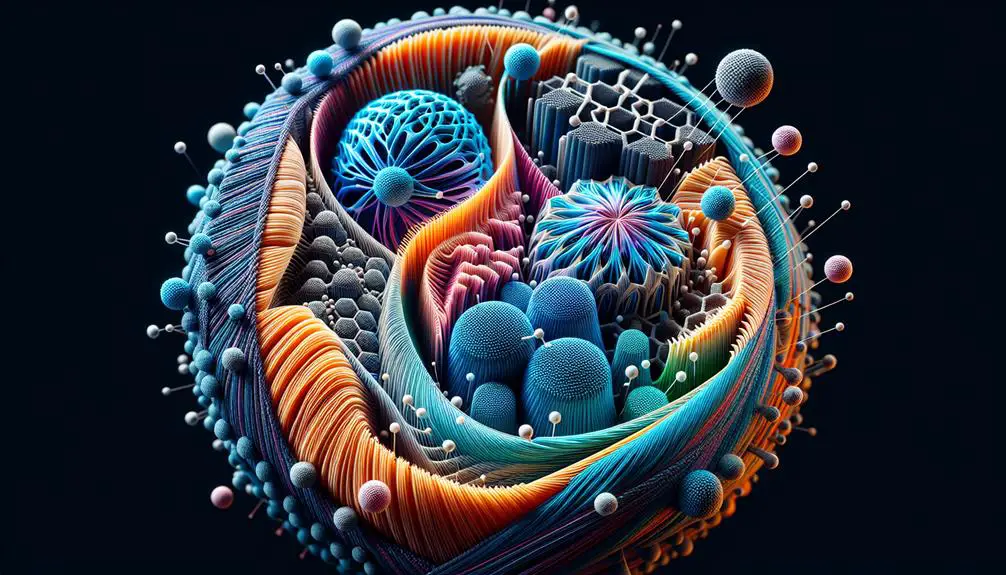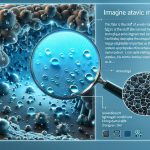You might not know that high-performance fabrics often start with the selection of innovative fiber blends that prioritize both functionality and sustainability. This is followed by advanced weaving techniques that enhance the fabric's durability and breathability. Nanotechnology applications and chemical treatments, such as water repellent coatings and UV protection agents, further elevate their capabilities. But how do these elements come together to create fabrics that manage moisture, regulate temperature, and stand up to rigorous use? Understanding the engineering behind these fabrics reveals a fascinating intersection of science and design.
Table of Contents
Key Takeaways
- Advanced weaving techniques combine fibers for enhanced durability, flexibility, and specific performance needs like moisture-wicking and thermal regulation.
- Nanotechnology applications improve fabric strength, UV resistance, and antimicrobial properties through nano coatings and nanoparticles.
- Chemical treatments provide water repellency, UV protection, and antimicrobial benefits, enhancing overall fabric functionality.
- Performance testing assesses durability, moisture-wicking, breathability, abrasion resistance, and temperature regulation to ensure high-performance standards.
- Sustainable fabric innovations include organic materials, textile recycling, biodegradable synthetics, and eco-friendly dyeing technologies to reduce environmental impact.
Material Selection
When choosing materials for high-performance textiles, you need to consider durability, breathability, and moisture-wicking properties. Fiber durability is vital, as the fabric should withstand rigorous use without deteriorating. You're searching for materials that maintain integrity after numerous washes and wears.
Color fastness is essential too, guaranteeing the fabric retains its vibrant hues even after exposure to sweat, sunlight, and repeated laundering.
To achieve peak performance, consider fibers recognized for their resilience and longevity, like polyester or nylon. These materials excel in maintaining fiber durability, providing you with a fabric that won't easily tear or lose shape. Moreover, color fastness in these fibers helps the fabric stay visually appealing over time.
Breathability and moisture wicking are crucial for comfort and performance. Fabrics such as merino wool or technical synthetics can effectively regulate body temperature and wick moisture away from the skin. This helps keep you dry and cool, even during intense physical activity.
When selecting your material, prioritize those with proven breathability and moisture-wicking capabilities to ensure the final fabric performs at its best. By focusing on these aspects, you'll create high-performance textiles that excel in both form and function.
Advanced Weaving Techniques
When exploring advanced weaving techniques, you'll encounter innovative fiber blends that enhance fabric performance.
Precision weave patterns also play a pivotal role, ensuring durability and flexibility.
These elements combined create high-performance fabrics that excel in various applications.
Innovative Fiber Blends
In today's textile industry, advanced weaving techniques are revolutionizing how innovative fiber blends enhance fabric performance. You're witnessing a transformation where customized blends and technological advancements converge, creating fabrics that excel in various applications.
By combining different fibers, manufacturers achieve performance enhancements that cater to specific needs, be it moisture-wicking, thermal regulation, or increased tensile strength.
These customized blends don't just offer superior functionality; they also contribute significantly to fabric durability. Imagine a fabric where synthetic and natural fibers are meticulously woven together, resulting in a product that not only feels luxurious but also withstands rigorous use.
The fusion of these fibers through advanced weaving techniques ensures that the benefits of each material are maximized, offering you a garment that performs exceptionally well under various conditions.
Technological advancements in fiber engineering have paved the way for these innovations. For instance, nanotechnology enables the creation of fibers with properties like UV resistance and antimicrobial features.
This means you get a fabric that not only lasts longer but also maintains its quality and performance over time. By understanding and utilizing these innovative fiber blends, you're setting yourself up for expertise in the domain of high-performance fabrics.
Precision Weave Patterns
Building on the benefits of innovative fiber blends, precision weave patterns further enhance fabric performance by optimizing the arrangement of fibers.
You'll find that these advanced weaving techniques employ customized designs to create intricate structures, which are meticulously engineered to meet specific performance criteria.
Whether you're aiming for increased durability, breathability, or moisture-wicking capabilities, the precise interlacing of fibers in performance enhancing weaves can make all the difference.
When it comes to specialized patterns, you'll see a variety of configurations designed to cater to distinct functional needs.
For instance, in athletic wear, a honeycomb weave may be utilized to boost stretch and flexibility, allowing for a greater range of motion.
In contrast, a tight plain weave might be chosen for protective gear, providing superior resistance against abrasions.
Nanotechnology Applications
Nanotechnology is revolutionizing high-performance fabrics by enhancing their strength, durability, and functionality. Imagine your favorite workout gear resisting sweat and stains effortlessly or your outdoor jacket becoming virtually indestructible—thanks to nano coating, these scenarios are now possible. Nano coatings are ultra-thin layers applied to fabric fibers, providing performance enhancements such as water repellency, UV protection, and even antibacterial properties.
By incorporating nanoparticles, manufacturers can engineer fabrics that outperform traditional materials. These enhancements don't add bulk or compromise comfort. For example, a nano-coating on a shirt can make it stain-resistant without making it stiff or uncomfortable.
| Feature | Traditional Fabric | Nano-Enhanced Fabric |
|---|---|---|
| Water Repellency | Low | High |
| Stain Resistance | Moderate | Excellent |
| Durability | Standard | Superior |
Moreover, nanotechnology enables you to enjoy benefits like increased fabric lifespan and reduced maintenance. You won't have to worry about frequent washes or replacements, making your high-performance gear more sustainable. The potential for customization is also immense; imagine fabrics tailored to meet specific needs, whether it's for extreme sports or everyday wear. With nanotechnology, the future of high-performance fabrics is not just promising—it's here.
Chemical Treatments
When it comes to high-performance fabrics, chemical treatments can greatly enhance their functionality.
You'll find water repellent coatings, UV protection agents, and antimicrobial treatments that offer added benefits.
These treatments guarantee your fabrics stay dry, block harmful rays, and resist bacteria.
Water Repellent Coatings
To keep your high-performance fabrics dry, water repellent coatings use chemical treatments that form a protective barrier against moisture. By applying these treatments, you can achieve a durable finish that guarantees longevity and functionality. The hydrophobic properties of these coatings make water bead up and roll off the fabric, preventing saturation and maintaining breathability.
When selecting water repellent coatings, consider:
- Durable finish: Guarantees long-lasting effectiveness through multiple washes and wear.
- Hydrophobic properties: Facilitates water resistance by repelling moisture.
- Eco-friendly alternatives: Seek out coatings with minimal environmental impact.
- Sustainable solutions: Opt for treatments that use biodegradable or renewable resources.
- Performance consistency: Guarantee that the coating maintains its properties under various conditions.
As you aim for mastery in fabric performance, understanding the balance between functionality and sustainability is essential. Eco-friendly alternatives and sustainable solutions are becoming increasingly important in the textile industry.
Many manufacturers now offer water repellent treatments that minimize environmental impact without compromising on performance. By choosing such options, you not only enhance the durability of your fabrics but also contribute to a more sustainable future.
UV Protection Agents
For high-performance fabrics, incorporating UV protection agents through chemical treatments is vital to shield against harmful ultraviolet rays and prolong fabric life. You want your fabrics to offer the highest UV protection levels without compromising on fabric durability. Chemical treatments can ensure that your fabric remains resilient and maintains its integrity under prolonged sun exposure.
However, it's essential to contemplate the environmental impact of these treatments. Opt for eco-friendly agents that don't contribute to pollution or resource depletion. Achieving this balance ensures not only high performance but also sustainability.
Additionally, fabric breathability is a key factor. You don't want your high-performance fabric to become stifling just because it offers UV protection. Modern chemical treatments are designed to enhance UV protection while maintaining, or even improving, the breathability of the fabric.
Here's a quick comparison:
| Aspect | Traditional Fabrics |
|---|---|
| UV Protection Levels | Low |
| Fabric Durability | Decreases over time |
| Environmental Impact | Often Negative |
| Fabric Breathability | Compromised |
| High-Performance Fabrics | High UV Protection, Durable, Eco-friendly, Breathable |
Antimicrobial Treatments
Incorporating antimicrobial treatments into your high-performance fabrics guarantees they stay fresh and hygienic even after prolonged use. These treatments are essential in enhancing the fabric's functionality by integrating cutting-edge chemical solutions that fend off bacteria and maintain cleanliness. Silver ions play a vital role in this process. When embedded in the fabric, they create a hostile environment for bacteria, significantly enhancing bacteria resistance.
Antimicrobial treatments offer several advantages:
- Odor control: Prevents the buildup of unpleasant smells, ensuring your garments remain fresh.
- Moisture management: Keeps the fabric dry by efficiently wicking away sweat and moisture.
- Enhanced durability: Prolongs the life of your fabric by reducing microbial degradation.
- Skin protection: Minimizes the risk of skin irritations and infections.
- Sustainability: Reduces the need for frequent washing, conserving water and energy.
Performance Testing
When evaluating high-performance fabrics, rigorous performance testing guarantees they meet industry standards and consumer expectations. You must ensure these fabrics undergo durability testing to confirm they can withstand prolonged use without compromising their integrity. This involves subjecting the material to repetitive stress conditions to measure its strength and longevity.
Moisture-wicking capabilities are essential for high-performance fabrics. Through meticulous testing, you can assess how effectively the fabric transports moisture away from the body. This ensures optimal comfort and dryness during high-intensity activities.
Furthermore, a breathability assessment is crucial. You need to test the fabric's ability to allow air and moisture vapor to pass through, ensuring the wearer remains cool and comfortable. This is especially important for athletic and outdoor apparel, where temperature regulation is key.
Don't overlook abrasion resistance. This testing involves evaluating how well the fabric can resist wear and tear from friction. By simulating real-world conditions, you can determine the fabric's durability and suitability for various applications.
Sustainable Fabric Innovations
Sustainable fabric innovations are revolutionizing the textile industry by prioritizing eco-friendly materials and processes. You're probably aware that traditional textile manufacturing has impactful environmental effects, but today's advancements are paving the way for a greener future. These innovations focus on minimizing waste and maximizing the lifecycle of materials, aligning perfectly with the principles of the circular economy.
Consider these key developments driving sustainable fashion:
- Eco-friendly alternatives: Materials like organic cotton, bamboo, and hemp are gaining traction as they require fewer resources to produce and are biodegradable.
- Textile recycling: Companies are now turning old garments into new fabrics, notably reducing landfill waste.
- Closed-loop systems: These systems recycle water and chemicals used in fabric production, reducing pollution.
- Biodegradable synthetics: Innovative fibers that break down naturally after use are entering the market, providing a cleaner alternative to traditional synthetics.
- Dyeing technologies: Advanced dyeing processes significantly reduce water and chemical usage, making the production process more sustainable.
Smart Fabrics
Imagine wearing clothes that can monitor your health, adjust to temperature changes, and even charge your devices. This isn't science fiction; it's the remarkable frontier of smart fabrics. These interactive textiles integrate wearable technology to enhance your everyday experiences.
By embedding sensors and microprocessors into the fabric, smart textiles can perform biometric monitoring, tracking metrics like heart rate, respiration, and hydration levels in real time. This data is invaluable for athletes, medical patients, and anyone keen on keeping a close eye on their health.
Temperature regulation is another impressive feature of smart fabrics. These textiles can adapt to your body's needs, using phase-change materials or thermochromic dyes to manage heat and cold more effectively. Imagine a shirt that cools you during a workout and warms you up when you step outside into the winter chill. This kind of responsiveness enhances comfort and performance, making your clothing an active participant in your well-being.
Moreover, some smart fabrics incorporate energy-harvesting technologies, allowing you to charge small electronic devices on the go. Imagine never worrying about a dead phone battery during your morning run. With smart fabrics, your clothing becomes a multifunctional extension of your lifestyle.
Future Trends in Textiles
You might soon find yourself wearing clothes that aren't just smart but also eco-friendly and adaptable to any situation. The future of textiles is brimming with innovations that promise to revolutionize your wardrobe. Here's what to expect:
- Biodegradable materials: Textiles designed to break down naturally, reducing environmental impact.
- Energy-harvesting fabrics: Clothes that can charge your devices or power wearable tech.
- Adaptive textiles: Fabrics that adjust to temperature, moisture, or even UV exposure.
- Recycled fibers: High-quality textiles made from post-consumer waste, promoting sustainability.
- Wearable sensors: Integrated technology that monitors health metrics, making your clothes functional and informative.
Smart textiles innovation is pushing the boundaries of what fabrics can do. Imagine a jacket that warms up when it's cold or a shirt that tracks your heart rate. These advancements aren't just about convenience but also about creating garments that contribute to a sustainable future.
Eco-friendly textiles are at the forefront of this movement, combining functionality with environmental responsibility. As these technologies evolve, you'll find your clothing becoming a seamless blend of style, performance, and sustainability, offering you the best of all worlds.
Frequently Asked Questions
How Do High-Performance Fabrics Impact Athletic Performance?
High-performance fabrics have a major impact on athletic performance. They enhance athlete comfort and performance through fabric breathability and moisture-wicking technology. You'll feel cooler and drier, allowing you to focus more on your training and competition.
Can High-Performance Fabrics Be Recycled or Repurposed?
Absolutely, high-quality fabrics can practically be reborn! You've got endless recycling opportunities and repurposing options. Immerse yourself in the world of sustainable fashion, where your gear isn't just top-tier but also eco-friendly!
What Are the Cost Differences Between Regular and High-Performance Fabrics?
You'll notice high-performance fabrics usually cost more due to enhanced fabric durability and advanced technology. However, the higher price often reflects their lower environmental impact and longer lifespan, offering better value in the long run.
How Do High-Performance Fabrics Affect Skin Health?
You'll love how high-performance fabrics benefit your skin health. While regular fabrics may cause skin irritation, these advanced textiles excel in moisture wicking, preventing discomfort and keeping your skin dry and irritation-free.
Are There Any Notable Brands Specializing in High-Performance Fabrics?
Yes, you'll find notable brands like Patagonia and Arc'teryx leading innovations in high-performance fabrics. They focus on sustainable practices, ensuring that their products not only perform excellently but also minimize environmental impact.
- How Does Ring Spun Cotton Affect Garment Fit and Shape Retention? - August 13, 2024
- What Are the Challenges in Producing Ring Spun Cotton? - August 13, 2024
- Is Ring Spun Cotton Suitable for Plus-Size Clothing? - August 13, 2024







